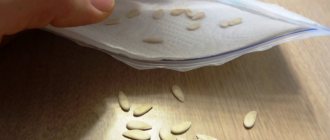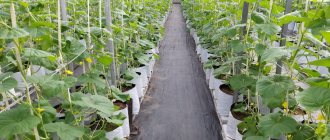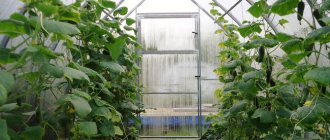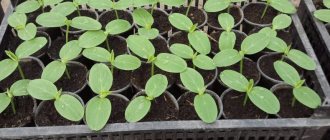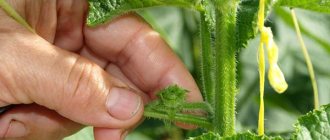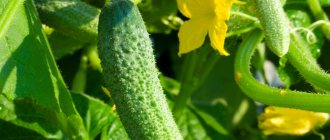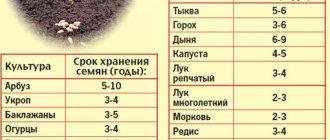It is impossible to imagine a Russian garden without cucumbers. And even though this vegetable contains practically no nutrients, crunching a green cucumber straight from the garden is an undoubted pleasure. Everyone plants cucumbers, because it is not at all difficult to do. For very early consumption, they even grow seedlings, but even when sowing seeds directly into the garden bed, summer harvests are always guaranteed.
- 2 Selection and preparation of seeds
- 3 Dates for planting cucumbers
- 4 Planting cucumbers for seedlings
- 5 Planting cucumbers with seeds in the ground
5.1 Video: sowing seeds in a garden bed
- 7.1 Growing on a trellis
7.1.1 Video: cucumbers under an apple tree
- 7.2.1 Video: planting cucumber seedlings in a barrel
Selection and preparation of soil and planting site
In different climatic conditions, the arrangement of beds for cucumbers is somewhat different. And if in the southern regions plantings are usually carried out on a flat surface, then in the middle zone more or less high ridges are equipped. To create a better air-thermal regime on heavy soils, the ridges are built higher; on light, warm soils they are made low. On slopes, ridges are made across the slope, on a flat surface - taking into account the best solar heating - from east to west.
In areas with high groundwater levels and heavy cold soils, it is widely practiced to sow cucumbers in separate raised earthen holes located at a distance of up to a meter from one another. In dacha practice, it is not uncommon to grow cucumbers on wall beds with or without film cover. To do this, use the southern walls of buildings or blind fences. If this is not possible, cucumbers are grown on trellises protected on the leeward side by a shield made of boards or film.
The fence is an excellent natural support for cucumbers, at the same time protecting them from the winds
In addition to being thermophilic, cucumbers require higher doses of fertilizers, especially organic ones, compared to many crops. Without a good supply of nutrients to the beds, harvests are delayed and small. Even fresh manure is good for cucumbers, especially if you apply it for autumn digging. But it is better, of course, that the manure is at least half-rotted; cucumbers can use such fertilizer at first. Peat-compost mixtures are also suitable, but mineral fertilizers are still added to any organic matter - 100 g/m2 of nitrophoska or at least a half-liter jar of wood ash.
Cucumbers do well in high, warm beds. To arrange them, at the end of last summer, a hole up to 30 cm deep was dug according to the size of the future bed. Various waste was dumped into it: plant tops, small branches, fallen leaves, household garbage, various cleaning products. All this is periodically watered with infusion of mullein or chicken droppings, sprinkled with earth or peat. In the fall, add good soil and form a ridge, limiting it along the sides with boards or slate.
In the spring, the bed is sprinkled with ash, loosened, watered with warm water and covered with film until sowing the cucumbers. In the northern part of our country, the film is not removed at all, but holes are made in it, where seeds are sown or cucumber seedlings are planted.
How to prepare the ground before planting
It is important to properly prepare even suitable soil for planting cucumbers. In beds arranged in boxes (greenhouses and bulk ones) , you can replace the old soil with fresh soil, prepared according to one of the recipes:
- Sawdust, rotted manure and peat are combined in a ratio of 1:2:2, after which 250-300 g of wood ash and a dessert spoon of superphosphate, urea and potassium sulfate are added to each bucket of the mixture.
- Mix equal amounts of humus, compost and turf. 25 g of superphosphate, a glass of ash and 15 g of potassium sulfate are diluted in 5 liters of water. This volume of liquid is poured into a bucket of soil mixture.
- Peat, mullein, sand, rotted manure and sawdust in a ratio of 5:1:1:1:1.
- Turf, compost, high peat and sawdust in equal parts.
In other cases, preparation begins in the fall . To do this, dig the bed to a depth of 25-30 cm and add 5-8 kg of manure and 10 g of fertilizer with potassium and phosphorus per 1 m2 of soil (can be replaced with a glass of ash).
Attention! If the soil is light and crumbly, then the addition of organic matter is postponed until spring.
Spring tillage before planting goes like this::
- A week before planting, the bed is dug up again, breaking up earthen lumps and removing weeds.
- Form grooves 20-30 cm deep and fill them with rotted manure, compost, hay, leaves or sawdust at the rate of 5 kg per 1 m2.
- The grooves are filled with fertile soil, loosened and covered with film.
- A day before planting, add a mineral complex of 45 g of superphosphate, 20 g of nitrate and 30 g of potassium salt.
If the bed is formed in an open area , not protected from direct sunlight, winds and drafts, it is recommended to plant corn or sunflowers around it.
Cucumber planting dates
The timing of sowing seeds or planting seedlings is linked to the fact that they are sensitive not only to frost, but also to low temperatures. Seedlings and seedlings, if not protected, may die when the soil temperature drops below 10 °C. Cucumber seeds germinate when the soil warms up to at least 14 °C. Based on this, we can conclude: in the middle zone, dry seeds should be sown after May 25, and sprouted seeds should be sown in early June. Cucumbers begin to grow and develop normally when the daytime air temperature reaches 25 °C.
As for the southern or northern regions, there the timing of sowing seeds in the ground shifts by 1–2 weeks in one direction or another. Based on the above, it is possible to estimate the timing of sowing seeds for seedlings. They will also depend on whether the seedlings are going to be planted in a greenhouse or in open ground. From the moment of sowing the seeds to planting the seedlings in the garden bed, 30–35 days should pass. This means that in the middle zone you need to sow seeds in cups at the very end of April. It will be possible to plant seedlings in a good greenhouse already in early May, which means that sowing seedlings begins around April 1.
The best time to build a warm bed for cucumbers
To avoid sudden changes in temperature for cucumbers, which are very sensitive to this at any stage of their development, warm beds should be prepared in the fall. This time is most suitable for a number of reasons:
- the harvest has already been completely harvested, and you can immediately decide on the location of the ridges;
- autumn pruning of trees has been done and the remaining wood can be placed on the lower drainage layer of the bed;
- a lot of ready-made plant materials suitable for use as subsequent layers of filling;
In spring there are fewer such opportunities, but you can still make a warm bed. During this period, it is recommended to start work around March-April, when the earth will not stick too much to the shovel when digging. In the spring, everything that is left over from last year's weeding or pruning of trees is usually used. You can also order the necessary humus in special stores or farms.
Planting cucumbers for seedlings
Since in many early-ripening hybrids the first cucumbers can be tasted already 33–38 days after emergence, the need for mandatory cultivation of seedlings is doubtful. But if you want to get your own products as early as possible, the gardener must grow a few seedlings. To do this, you should highlight the most illuminated window sill.
Cucumbers are very sensitive to any transplantation, so the seeds are sown immediately in individual cups with a capacity of 300 ml or more, or better yet, in medium-sized peat pots. For a dozen bushes, it is better to buy soil in a store, but if you have everything at home to prepare light, moisture-intensive and breathable soil, you can do it yourself, be sure to add fertilizers to it (compost, ash, nitrophoska). Sowing cucumber seeds in cups is not difficult.
- Place 1-2 seeds on the surface of moist soil (preferably 2-3, but seeds have become very expensive!).
Since each seed already costs more than one ruble, you have to sow one in a glass
- Cover the seeds with a layer of soil about 1.5 cm thick.
- Water the crops very carefully, preferably with a spray bottle.
- Place the cups in a warm, illuminated place (optimally at a temperature of 25–28 °C) and cover with glass or film.
Glass above the cups creates a good greenhouse effect
The emergence of cucumber seedlings occurs in 4–8 days, depending on the variety and temperature. A few days after germination, the frailest plants should be carefully trimmed with scissors. As soon as the shoots appear, the glass is removed, and the temperature is lowered to 18 ° C, several degrees lower at night, and this is left for five days. If this is not done, the seedlings will stretch out and be very weak.
In the future, the optimal temperature is about 24 ° C during the day and 18 ° C at night. If there is not enough sunlight, it is necessary to organize additional lighting with fluorescent lamps or diode lamps. The rest of caring for seedlings is the same as for any vegetable plants: moderate watering, fertilizing if necessary, hardening off before planting in the ground.
Recent Entries
Lilac perennials that are beautiful, compact and do not crowd out other plants Why when buying seedlings you should not take the sellers’ word for it and how to determine the age of the plant using 3 signs Tomato seedlings have turned purple or whitish: why the color has changed and how to save the plants
Proper care of greenhouse cucumbers
Caring for cucumbers is necessary: forming a bush, loosening the soil, tying, weeding and fertilizing. Do not expose vegetables to sudden changes in temperature. If at night the average temperature is 11 degrees, and during the day - 24 degrees, then the ovaries will be weak. But if during the day it is from 12 to 15 degrees, the root system will stop absorbing moisture, then the leaves will begin to turn yellow, and eventually they may dry out and die. To prevent this from happening, you need to properly care for your plants.
Other varieties also need care. When growing bee-pollinated varieties, bee baiting tactics are used. Sugar syrup is suitable for these purposes. But they can harm the parthenocarpic variety; in this case, the corolla is removed before the flower opens. Then the bees will not be able to land on the flowers, but in the absence of a corolla, the cucumbers will not stop developing ovaries.
Important! Gardeners who use parthenocarpic varieties for cultivation should know that when the first female flowers appear, pollination is carried out by hand
Watering greenhouse cucumbers
It is necessary to ensure soil aeration, because cucumbers prefer moisture, and if there is a lack of oxygen, the plant may die. Normal soil moisture should be between 70% and 80%. Water for irrigation is heated to 25 degrees, watering is carried out in the morning. Cucumber leaves should not be watered, otherwise yellow spots will form.
Before flowering itself, watering is done once a week, but after that, at normal temperatures, it should be watered a couple of times in 7 days. In hot weather it is necessary to provide moisture every day. You should not hose down the plants; only the soil is moistened, not the cucumbers themselves.
Feed additives for cucumbers in a greenhouse
Excess or lack of fertilizer is determined only by the appearance of the cucumbers. Determination methods:
- Experienced gardeners say that in case of an excess of nitrogen, the plant becomes excessively green and active bud formation begins, but such plants will not bear fruit. Sluggish development is due to a lack of nitrogen, cucumber foliage has a pale green color, their stems are very thin, then yellow color appears and dieback.
- Potassium starvation manifests itself in the form of brown, drying foliage; as a result, the foliage begins to die. This symptom has a name - opal or burn. The cucumber fruits themselves acquire an arched hook shape.
- A lack of magnesium is expressed in intervein chlorosis, the veins of the plant turn green, but the tissue becomes lighter.
- For growing cucumbers in a greenhouse, a lack of phosphorus is considered a rare occurrence; with such a shortage, the plant grows slowly, the foliage becomes small, then the leaves acquire a blue tint, then they become dark and withered.
Only by these signs can a lack of nutrients be determined. In order not to wait for such symptoms to appear, uniform feeding of cucumbers is allowed. The first fertilizing is done at the first stages of fruiting - 25 days after planting, then fertilizing is done once every 10 days. Cucumbers categorically do not accept chlorine, so potassium chloride and potassium salt should be excluded. The following substances are considered beneficial: potassium sulfate and potassium nitrate. It is preferable for cucumbers to fertilize with substances in a liquid state.
Cucumber planting schemes
There are different layouts of cucumbers in the garden. There are three most common ones.
- The row method involves planting cucumbers in a garden bed in just one row, therefore, there is a free passage between the rows, the distance between the rows is about a meter (in greenhouses it is reduced to 70 cm). Plants in rows are placed at a distance of 15–30 cm from each other.
- The tape (two-line) method involves placing two rows on a standard bed at a distance of 30–50 cm from each other. If there are several beds (and therefore ribbons), leave 90 to 150 cm between them. Sowing (planting) cucumbers is carried out at approximately the same density as with a single-row arrangement.
In summer cottages, strip planting is one of the most popular
- Square-cluster planting pattern. In this case, the nests are located at a distance of 65–70 cm from each other, sometimes in a checkerboard pattern. Up to a dozen seeds are sown in a hole with a diameter of about 12 cm, and after germination, 5–6 of the most developed and conveniently located plants are left. Assuming such a scheme, it is possible to grow several specimens in a pot at once at the seedling stage.
How does a warm bed work?
The basic principle of operation of warm beds is very similar to the principle that occurs when preparing compost. In both cases, the contents are heated due to the decomposition processes of organic waste, releasing a significant amount of methane. The resulting warmth and excellent nutrient medium are precisely the components that are necessary for the successful growth of cucumbers and their fruiting.
In view of this, properly laid warm ridges have undeniable advantages:
- warm soil is an excellent environment for the proliferation of microorganisms, and their vital activity is beneficial for the development of plants;
- guarantee of a good harvest;
- saving labor, time and money.
Since the considered option for creating insulated beds for cucumbers is very similar to creating layered compost heaps, the rules for creating them are not much different from each other:
- It is important to provide the necessary ventilation at the required humidity (to prevent mold from appearing);
- The first layer is traditionally made from raw materials that take a long time to rot (branches, thick stems, wood). Its thickness can vary between 40...45 cm;
- each subsequent layer of the warm bed is thoroughly moistened, it should not dry out;
- Only healthy plants without seeds go into the “stuffing”.
Methods for planting cucumbers
In addition to the completely natural cultivation of cucumbers in beds “as is,” that is, with the vines placed on the ground, there are various options aimed at saving space in the garden. And if in greenhouses cucumbers were always grown on trellises or, at least, tying the vines in a vertical direction, then the trellis method became almost traditional among land-poor summer residents relatively recently. And after it, more exotic options appeared.
Growing on a trellis
It has been noticed that cucumbers planted close to trees easily climb to incredible heights, as a result of which both apples and cucumbers can be collected from one tree. It’s hard to say why, but in my garden, cucumbers are more partial to powerful apple trees than to less respectable cherries or plums.
Using this fact, many gardeners plant cucumbers next to natural supports (for example, a fence) or specially build them for them. Vertically growing cucumbers not only save space in the garden. They are much easier to care for, easier to collect, and the fruits hang clean.
Video: cucumbers under an apple tree
When grown on a trellis, plants can be planted more densely (the distances both in the row and between the rows are reduced). Therefore, the amount of fertilizer applied must be increased. Since it is undesirable to grow one crop for several years in a row in one place, craftsmen design the trellis to be easily dismountable or portable. In this case, the distance between the posts is maintained at about 1 meter, and several rows of wire are stretched across them.
In order for cucumbers to climb onto the trellis, it is often necessary to first tie the plants with soft twine. The situation is simpler if there is a mesh with large cells (at least 15 cm). By placing such a net vertically, you don’t have to worry: the cucumbers will behave like a vine. You can do it differently by stretching only one wire at a distance of about 2 meters from the ground. Cucumbers are tied with twine at a height of 10–15 cm from the ground, and this twine is tied to the wire. The technique of sowing seeds or planting seedlings does not differ from that of conventional cultivation.
A vertically placed mesh solves many problems with cucumber agricultural technology
Growing cucumbers in a barrel
Using old barrels is becoming a popular way to grow many vegetables that grow in large clumps. This is how they plant, for example, melons, watermelons, pumpkins, even strawberries. This saves space in the garden (the barrel can be placed anywhere), and the plants are in well-warmed soil. Any barrel, but preferably an iron one, dark-colored and full of holes, is filled halfway with all sorts of organic debris, and fertile soil, well flavored with humus, is placed above it. In the spring, water the contents with mullein infusion and cover with film to warm up.
Already in mid-May (for the middle zone), cucumber seeds can be sown in a barrel under temporary shelter. Since bushes grow faster in warm soil, it is more profitable to plant the earliest ripening varieties in a barrel; they can catch up with greenhouse varieties. Over time, due to the rotting of the remains, the soil in the barrel will still settle, so there are no problems with temporarily sheltering the bushes from cold weather. And by the onset of real summer, the shelter is removed, and the lashes are either allowed to hang down or sent to specially constructed arcs.
Barrels with planted cucumbers even decorate the area
The advantages of using barrels are obvious; it is much easier to care for cucumbers in them, but you have to water them more often than in a garden bed.
Video: planting cucumber seedlings in a barrel
Growing cucumbers in bags or tires
Instead of barrels, you can use large garbage bags with almost the same success. Most often, bags with a capacity of 100–120 liters are taken for this purpose. True, they are less stable than barrels, so they are reinforced with any wooden frame. They also drive a stake inside to tie the lashes. Cucumbers in bags have to be watered frequently, daily in hot weather.
Bags of cucumber plants can be transported from place to place
Instead of bags, sometimes they use several old car tires, placing them on top of each other in a cylinder (if they are the same size) or a pyramid. Since the tires are black, the soil inside them is quickly warmed by the sun. Drainage material is placed at the bottom of the pyramid, and then nutrient soil. Planting and care are the same as in barrels or bags.
How to determine acidity
When preparing the soil in a greenhouse, it is necessary to conduct an analysis to determine the level of acidity. If the analysis shows a value of 7, then you can safely start planting plants. As already mentioned, soil acidity is of great importance for the growth and development of the plant. Not to mention the fertility of the crop. The pattern here is quite simple. The higher the indicator, the higher the likelihood of normal plant development. But, at the same time, too high acidity of the soil negatively affects growth.
This requires expert judgment. To do this, you need to seek help from a specialized laboratory. The analysis is carried out using a special Alyamovsky device. If desired and possible, you can purchase this device, which will allow you to determine the condition of the soil at any time. Of course, this option is suitable for farmers who grow cucumbers on a large scale.
An equally popular option is to use special litmus paper. It can be found in a store that sells chemical reagents. Soil analysis is carried out in the following sequence:
- cut off the top layer of humus 30 cm thick;
- moisten it with distilled water;
- Wrap part of the mixture in paper and knead.
As a result, the paper will change shade. The color is compared with a control scale. Next, by coincidence, the acidity of the soil is determined.
If this is not possible, then the usual method of observation and analysis must be used. So, if woodlice, horse sorrel or horsetail sprout in the area, this indicates that the soil here is highly acidic. The only solution is to lower the level. It is best to do this with slaked lime, which is freely available. If clover or thistle grows in the area, this indicates that its acidity is low.
The soil is prepared very carefully
This is very important, since the yield of cucumbers depends on it. If you prepare everything well, the result will be amazing.
After what crops can cucumbers be planted?
Cucumbers should not be grown in one place for two years in a row; it is advisable to plan the return of the crop to the garden in the third or fourth year. This is due to the fact that they greatly deplete the soil of nutrients, especially nitrogen. Therefore, it is best to plant them after those crops that absorb little nitrogen, and even better, enrich the soil with it. Such vegetables exist: these are beans, beans and peas. After fruiting, legumes are not pulled out, but cut off: nitrogen-fixing bacteria are present on the roots, so the roots are left in the soil.
Good predecessors are garlic or onions, which clean the soil well from harmful microflora and are excellent orderlies: after them you can plant almost any vegetables. Nightshades (tomatoes, peppers) behave similarly. Cucumbers also grow well after potatoes, carrots or beets. Various cabbage vegetables are also good predecessors.
You should not plant cucumbers after any pumpkin crops (zucchini, squash, watermelons, melons). Plants of the same type have the same pests that can remain overwintering in the soil. And they consume nutrients basically in the same proportion.
Preparing the bed in spring
In the spring, when cucumber seedlings are planted, after the soil is saturated and tested for acidity, you should begin to form the beds. The surface on which the planting will be carried out must be absolutely flat. Mid-level beds are then formed on it, using either the strip or wide-row method. Taking into account that there will be a gap of eighty centimeters between the rows.
If we talk about the tape, then between the rows you should leave a gap of forty centimeters, between all plants you should leave twenty-five centimeters. In this case, the optimal width of the path should be about thirty centimeters (calculating 4 plants per square meter).
On such ridges, optimal conditions will be created for growing cucumbers, because there will be thorough air exchange of the roots of the plant, and the plant itself will be closer to the light source.
